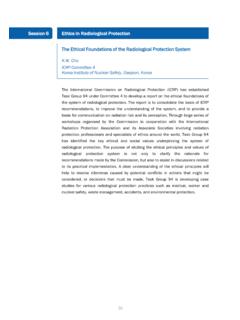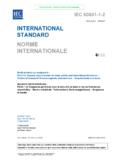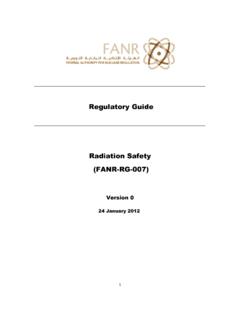Transcription of 9 Radiological aspects - World Health Organization
1 197 The objective of this chapter is to provide criteria with which to assess the safety ofdrinking-water with respect to its radionuclide content. The Guidelines do notdifferentiate between naturally occurring and artificial or human-made guidance values for radioactivity in drinking-water recommended in the firstedition of the Guidelines were based on the risks of exposure to radiation sources andthe Health consequences of exposure to radiation. The second edition of the Guidelinesincorporated the 1990 recommendations of the International Commission on Radio-logical Protection (ICRP, 1991).
2 The third edition incorporates recent developments,including the ICRP publications on prolonged exposures and on dose hazards may derive from ionizing radiation emitted by a number ofradioactive substances (chemicals) in drinking-water. Such hazards from drinking-water are rarely of public Health significance, and radiation exposure from drinking-water must be assessed alongside exposure from other approach taken in the Guidelines for controlling Radiological hazards has twostages: initial screening for gross alpha and/or beta activity to determine whether the activity concentrations (in Bq/litre) are below levels at which no further actionis required.
3 And if these screening levels are exceeded, investigation of the concentrations of indi-vidual radionuclides and comparison with specific guidance risk due to radon in drinking-water derived from groundwater is typically lowcompared with that due to total inhaled radon but is distinct, as exposure occursthrough both consumption of dissolved gas and inhalation of released radon and itsdaughter radionuclides. Greatest exposure is general ambient inhalation and inhala-tion from terrestrial sources, where the gas is infiltrating into dwellings, especially intobasements.
4 Radon of groundwater origin would usually be a small increment of thetotal, but may indicate deposits in the region that are emitting into screening and guidance levels apply to routine ( normal ) operational condi-tions of existing or new drinking-water supplies. They do not apply to a water supply9 Radiological aspectsGUIDELINES FOR DRINKING-WATER QUALITY198contaminated during an emergency involving the release of radionuclides into theenvironment. Guidance and generic action levels covering emergency situations areavailable elsewhere (IAEA, 1996, 1997, 1999, 2002).
5 The current Guidelines are based on: a recommended reference dose level (RDL) of the committed effective dose, equalto mSv from 1 year s consumption of drinking-water (from the possible totalradioactive contamination of the annual drinking-water consumption). Thiscomprises 10% of the intervention exemption level recommended by the ICRPfor dominant commodities ( , food and drinking-water) for prolonged expo-sure situations, which is most relevant to long-term consumption of drinking-water by the public (ICRP, 2000).
6 The RDL of mSv is also equal to 10% of thedose limit for members of the population, recommended by both the ICRP (1991)and the International Basic Safety Standards (IAEA, 1996). These are accepted bymost WHO Member States, the European Commission, FAO and WHO. dose coefficients for adults, provided by the additional risk to Health from exposure to an annual dose of mSv associatedwith the intake of radionuclides from drinking-water is considered to be low for thefollowing reasons: The nominal probability coefficient for radiation-induced stochastic Health effects,which include fatal cancer, non-fatal cancer and severe hereditary effects for thewhole population, is 10-2/Sv (ICRP, 1991).
7 Multiplying this by an RDL equalto mSv annual exposure via drinking-water gives an estimated upper-boundlifetime risk of stochastic Health effects of approximately 10-4, which can be con-sidered small in comparison with many other Health risks. This reference risk esti-mation for radionuclides is quite reliable due to the extensive scientific databasesthat have included human population exposure data. As with chemical carcinogenrisk extrapolations, the lower-bound risk is zero. Background radiation exposures vary widely across the Earth, but the average isabout mSv/year, with the highest local levels being up to 10 times higher withoutany detected increased Health risks from population studies; mSv therefore represents a small addition to background Sources and Health effects of radiation exposureEnvironmental radiation originates from a number of naturally occurring andhuman-made sources.
8 Radioactive materials occur naturally everywhere in the en-vironment ( , uranium, thorium and potassium-40). By far the largest proportionof human exposure to radiation comes from natural sources from external sourcesof radiation, including cosmic and terrestrial radiation, and from inhalation or inges-tion of radioactive materials (Figure ). The United Nations Scientific Committee9. Radiological ASPECTS199on the Effects of Atomic Radiation (UNSCEAR, 2000) has estimated that the globalaverage annual human exposure from natural sources is mSv/year (Table ).
9 Some sources ( , uranium) can be concentrated during extraction by mining andother industrial are large local variations in human exposure to radiation, depending on anumber of factors, such as height above sea level, the amount and type of radio-nuclides in the soil (terrestrial exposure), the composition of radionuclides in the air,food and drinking-water and the amount taken into the body via inhalation or inges-tion. There are certain areas of the World , such as parts of the Kerala state in Indiaand the Pocos del Caldas plateau in Brazil, where levels of background radiation areRadon (naturalinternal exposure)43%Earth gammaradiation(natural externalexposure)15%Cosmic rays(natural external exposure)13%Medical exposure20%Food, water(natural internalexposure)8%Other artificial(human-made)
10 Sources1%Figure Sources and distribution of average radiation exposure for the World populationTable Average radiation dose from natural sourcesWorldwide averageannual effective doseTypical rangeSource(mSv)(mSv)External exposureCosmic gamma exposureInhalation (mainly radon) 10bIngestion (food and drinking-water) 10aTerrestrial exposure is due to radionuclides in the soil and building from inhalation of radon may exceed 10 mSv/year in certain residential : UNSCEAR (2000).GUIDELINES FOR DRINKING-WATER QUALITY200relatively high.














